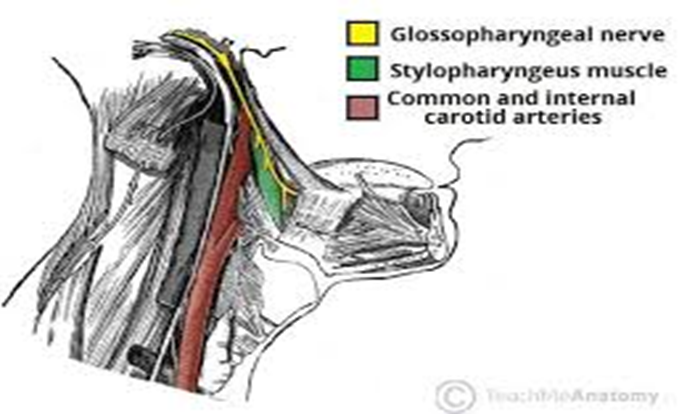What cranial nerve is responsible for the taste sensation of the posterior third of the tongue?

Facial
Abducens
Glossopharyngeal
Hypoglossal
The Correct Answer is C
Choice A Reason:
The facial nerve, or cranial nerve VII, is responsible for the taste sensation in the anterior two-thirds of the tongue, not the posterior third. It carries taste sensations from the front part of the tongue via the chorda tympani branch.
Choice B Reason:
The abducens nerve, or cranial nerve VI, has no role in taste sensation. It is primarily involved in controlling the lateral rectus muscle of the eye, which abducts the eye.
Choice C Reason:
The glossopharyngeal nerve, or cranial nerve IX, provides special sensory innervation for taste to the posterior third of the tongue. This enables the sensation of various tastes like salty, sweet, sour, and bitter in this region.
Choice D Reason:
The hypoglossal nerve, or cranial nerve XII, is responsible for motor control of the tongue muscles but does not provide sensory innervation for taste.
Nursing Test Bank
Naxlex Comprehensive Predictor Exams
Related Questions
Correct Answer is B
Explanation
Choice a reason:
Educational Prevention is not a recognized level of prevention in healthcare. While education is a key component in all levels of prevention, it is not a standalone category. Education is typically included in primary prevention as it involves informing the public about health practices to prevent the onset of disease.
Choice b reason:
Tertiary Prevention is the level of prevention that aims to manage and treat an existing disease to prevent further complications or deterioration. In the case of immobile stroke patients, tertiary prevention would involve measures to prevent skin breakdown and other complications associated with immobility and the stroke's long-term effects.
Choice c reason:
Secondary Prevention involves early detection and prompt intervention to prevent the progression of a disease. For stroke patients, secondary prevention might include monitoring for signs of skin breakdown so that early treatment can be initiated. However, the scenario described focuses on managing an existing condition rather than early detection.
Choice d reason:
Primary Prevention aims to prevent the disease or injury before it occurs. This would involve strategies to prevent strokes in the first place, such as controlling high blood pressure or encouraging healthy lifestyle changes. It does not directly relate to the prevention of skin breakdown in patients who have already had a stroke.
Correct Answer is B
Explanation
Choice A Reason:
The conjunctiva can sometimes appear yellow in individuals with jaundice; however, it is not the most reliable area to inspect for jaundice. The conjunctiva may be affected by other factors such as environmental irritants or infections, which can alter its appearance.
Choice B Reason:
The sclera of the eye is the most reliable area to inspect for jaundice. The yellowing of the sclera, also known as scleral icterus, is a key indicator of jaundice. The sclera's white background provides a clear contrast, making any yellow discoloration more noticeable. This is particularly true in darker-skinned individuals, where skin changes may be less apparent.
Choice C Reason:
The back of the neck is not a reliable area to inspect for jaundice. Skin pigmentation and lighting can affect the visibility of yellowing, making it an unreliable indicator. Additionally, the back of the neck may have other skin changes unrelated to jaundice that could confuse the assessment.
Choice D Reason:
The palms of the hands are not the most reliable area to inspect for jaundice. While the palms may show yellowing, they are subject to various external factors such as manual labor or exposure to substances that can affect their color. Moreover, the palms' skin may be thicker and less transparent, making subtle changes in color more difficult to detect.
Whether you are a student looking to ace your exams or a practicing nurse seeking to enhance your expertise , our nursing education contents will empower you with the confidence and competence to make a difference in the lives of patients and become a respected leader in the healthcare field.
Visit Naxlex, invest in your future and unlock endless possibilities with our unparalleled nursing education contents today
Report Wrong Answer on the Current Question
Do you disagree with the answer? If yes, what is your expected answer? Explain.
Kindly be descriptive with the issue you are facing.
